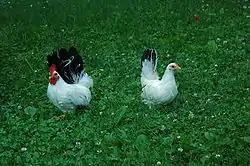Japanese bantam
The Japanese bantam or Chabo is a breed of chicken originating in Japan. It is a true bantam breed, meaning that there are no large fowl counterparts. It has a large upright tail that often reaches over the bird's head. The wings angle down, and to the back, along the sides.
 A pair of black-tailed Japanese bantams | |
| Other names | |
|---|---|
| Country of origin | Japan |
| Distribution | South Asia |
| Use | fancy |
| Traits | |
| Weight | |
| Skin color | yellow |
| Egg color | cream or tinted |
| Comb type | single |
| Classification | |
| APA | single comb clean-legged[4] |
| EE | yes[5] |
| PCGB | True bantam[6] |
| APS | True Bantam Softfeather Light Breed[3] |
| |
Characteristics

The Japanese bantam has very short legs.[7]:142 This trait is caused by a single lethal gene. All proper Japanese bantams are then heterozygous meaning that when the birds are bred, 25% of the embryos will receive two mutant alleles and die in shell. The other 50% of the embryos will receive one mutant allele and one wild type allele and will then be short-legged. The remaining 25% receive two wild type alleles and have legs that are longer than what most breeders want. Long-legged birds bred to each other will never produce short-leg offspring.
There are many colour varieties of Japanese bantam, with standardised colours including birchen grey, black, black mottled, black-tailed buff, black-tailed white, blue, blue mottled, blue-red, brown-red, buff Columbian, cuckoo, dark grey, golden duckwing, gray, lavender, Miller's gray, partridge, red, red mottled, silver-grey, tri-coloured, wheaten and white.[5] There are also frizzle-feathered[3] and Silkie-feathered variations.[8] These chickens have been known to live for up to 13 years with proper care.
References
- Breed data sheet: Shojo chabo/Japan. Domestic Animal Diversity Information System of the Food and Agriculture Organization of the United Nations. Accessed August 2014.
- Breed data sheet: Katsura chabo/Japan. Domestic Animal Diversity Information System of the Food and Agriculture Organization of the United Nations. Accessed August 2014.
- Australian Poultry Standards (2nd ed.). Victorian Poultry Fanciers Association (trading as Poultry Stud Breeders and Exhibitors Victoria). 2011. p. 88 & 91. ISBN 9781921488238.
- APA Recognized Breeds and Varieties: As of January 1, 2012. American Poultry Association. Archived 4 November 2017.
- Liste des races et variétés homologuée dans les pays EE (28.04.2013). Entente Européenne d’Aviculture et de Cuniculture. Archived 16 June 2013.
- Breed Classification. Poultry Club of Great Britain. Archived 12 June 2018.
- Victoria Roberts (2008). British poultry standards: complete specifications and judging points of all standardized breeds and varieties of poultry as compiled by the specialist breed clubs and recognised by the Poultry Club of Great Britain. Oxford: Blackwell. ISBN 9781405156424.
- http://www.aviculture-europe.nl/nummers/12E02A04a.pdf
| Wikimedia Commons has media related to Japanese Bantam. |